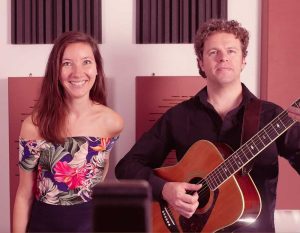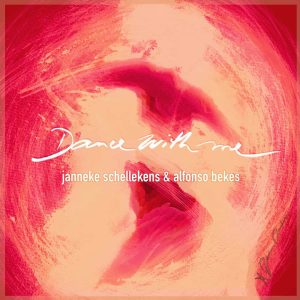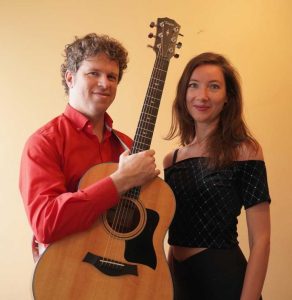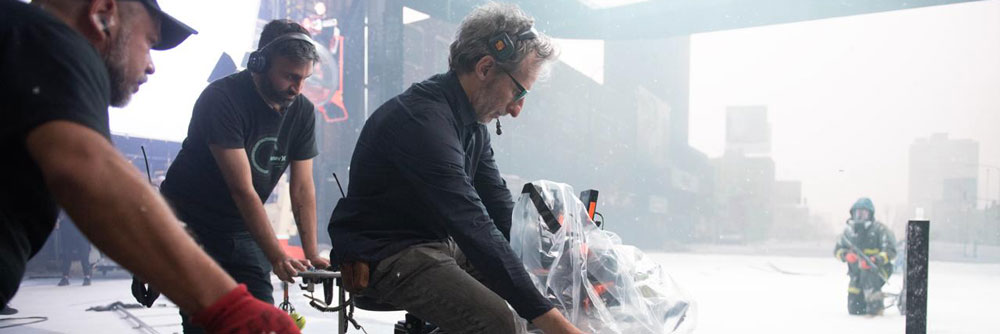TEXTO FRANCO GIORDA

Las almas sensibles no dejan de buscarse entre sí para generar, a partir del arte por ejemplo, un espacio mejor donde estar (y resistir). Es el caso de Janneke Schellekens de Países Bajos y del entrerriano Alfonso Bekes que en un singular cruce han grabado el álbum Dance with me. Este impulso vital de la cantante y el guitarrista permite que la música suene en medio del árido viento del presente para conmover, a pesar de todo, los corazones de acá, de allá y de todas partes.
La producción consta de cinco canciones originales y de tres covers de obras de Tina Dickow, Bonnie Raitt y David Crosby en formato acústico de guitarra y voces. Está disponible en Bandcamp donde se puede escuchar y acceder a las letras. Existe también la posibilidad de adquirirlo para escucharlo sin límites. El arte de tapa es obra de Gina Anders.
El dúo comenzó en 2014 cuando Janneke vivió una temporada de seis meses en Argentina. En 2020 comenzaron a componer canciones juntos y en diciembre de 2023 grabaron este primer álbum de estudio. El registro se realizó en sesiones acústicas en vivo.
«Nos conocimos en un recital de La Rifa del Viento. Después hablamos de juntarnos a hacer música porque a Janne le gustaba cantar algunas canciones de rock nacional. En nuestro primer encuentro tocamos Muchacha ojos de papel de Luis Alberto Spinetta y pasó algo especial y muy fuerte emocionalmente. Digamos que allí nos dimos cuenta de que había una gran conexión. En 2018 ella vino por segunda vez y grabamos tres covers que pueden escucharse en mi canal de youtube; en dos de ellos participa también Emilia Cersofio. En 2020 empezamos a componer canciones juntos, a distancia. Compusimos así tres temas» dijo Alfonso Bekes a 170 Escalones.
Janneke que actualmente se encuentra en Argentina agregó que «en 2023 nos vimos cuatro veces durante pocos días. Dos veces nos encontramos en Buenos Aires y dos en Paraná. En el primer encuentro compusimos cuatro temas nuevos y nos dimos cuenta de que había un buen material para grabar un álbum. También seguimos refinando algunos arreglos y canciones que ya teníamos en común. La grabación fue en el estudio de Edu Vilar en dos sesiones vespertinas de diciembre pasado durante los últimos días de mi estadía».
Alfonso también afirmó que «una cosa que teníamos en claro era que la orientación era hacia una estética acústica, folk, grabando sin metrónomo y editando lo menos posible».

La correspondencia mutua de la que hablan los artistas se escucha claramente en las canciones. La voz profunda de Schellekens y el prodigioso pulsado de las cuerdas y el canto de Bekes se enaltecen mutuamente para elevar también a quien escucha. En este diálogo entre el instrumento y las voces humanas hay una auténtica incorporación de distintas tradiciones vinculadas a la música argentina, al rock y al folk para dar luz a nuevas y propias piezas. Las referencias musicales más explícitas están dadas por los temas de los artistas elegidos para versionar. A su vez, en ritmos, melodías y cadencias se reconocen y actualizan estilos y líneas estéticas. Las distintas latitudes en las que nacieron Alfonso y Janneke están presentes en el nuevo territorio común que permite la música que ambos proponen.
A continuación, el intercambio mantenido con los artistas bajo la feliz e inagotable forma de las preguntas y las respuestas.
— ¿Cómo fue el proceso de composición y de grabación? El hecho de que las letras sean en inglés, ¿responde a algún motivo en particular?
— Decidimos componer en inglés principalmente porque Alfon tenía mucha música en castellano ya grabada y queríamos abrir la propuesta a un público más amplio, que no necesariamente manejara el español. A mí, me gustaría cantar más cosas en castellano, pero por el momento nuestro repertorio es en inglés. El proceso de composición por lo general comienza con una idea musical o letrística de alguno de los dos. A partir de ahí lo vamos charlando. Nos escuchamos bien y nos damos un tiempo para que el otro pueda asimilarlo. Volvemos a hablar luego e intercambiamos ideas, probamos cosas juntos y tomamos decisiones. La música también nos lleva en cierta dirección. A mí me encanta que cuando tengo una idea sobre la letra o la melodía y hablamos, Alfon sabe traducir directamente esas ideas a la guitarra, a la música. — expresó Janneke.
— Siempre vamos grabando e intercambiando esos embriones que van mutando continuamente hasta llegar a la versión «final». No existe la versión final, en realidad, es que la grabación de un disco genera esa fotografía que cristaliza un momento. También hablamos mucho sobre el concepto de lo que queremos lograr con una letra o una música. A veces, de una charla casual, de amigos, sale una frase, una imagen que tiene una resonancia especial. Inmediatamente sabemos que allí hay algo que nos habla. Que nos está pidiendo expresión – dijo Alfonso
— ¿Por qué eligieron hacer covers de Tina Dickow, Bonnie Raitt y David Crosby?
— Yo propuse el tema de Dickow y el tema de Bonnie Raitt, que en realidad nos enteramos que es de John Prine. Alfon propuso el tema de Crosby. Para mí Angel From Montgomery y No time to sleep son canciones que me marcaron por formar parte de una etapa de mi vida. Esas canciones son parte de mí y las llevo conmigo. Son temas que toqué y canté con varios amigos. Son canciones que me atraen no solo por lo musical, sino por lo que representan para mí en cuanto a encuentros, emociones, además de lo que dice la letra — afirmó Janneke

— ¿Cómo definirían esta producción musical?
— Es un álbum acústico de canciones folk, con influencias de la música argentina. Por ejemplo, el primer tema es una milonga y el segundo es un candombe. También hay influencias de la parte del repertorio de rock que más nos atrae, podríamos decir que el último tema del disco tiene una guitarra bastante cercana a Jimmy Page o que la anteúltima canción tiene una reminiscencia al Chris Cornell acústico. Ya comentamos que el primer tema que hicimos juntos fue de Spinetta. Todos esos elementos conviven entrelazados, no como islas independientes. Las letras suelen tener un arco desde lo íntimo hacia lo universal. Por ejemplo, en Pick up your pieces, la muerte de una persona cercana nos llevó a la reflexión de cómo, a veces, aún con las mejores intenciones, nos conducimos individual o colectivamente hacia el abismo — explicó Alfonso.
— En Dance with me, el tema que abre el disco, la letra surgió como una descripción de lo que yo busco en conexión con una pareja de baile de tango. Un espacio vulnerable donde no es necesario fingir nada. Podes llegar a ese lugar con todo lo que sos, todo lo que sentís. Una total aceptación de cómo están en ese momento dos personas que se conectan a través de la danza, y que esta les permite expresar.
— ¿Tienen previsto presentar el disco en vivo o de alguna otra manera?
— El año pasado hicimos un recital en el barrio de Caballito en el que presentamos en vivo todos los temas, en formato acústico, me refiero a que no hubo amplificación. Asistieron unas 25 personas de nacionalidades diversas y fue una tarde de una sensibilidad compartida muy intensa y, a la vez, por lo diverso del público, se sintió como tocar en otro país. Obviamente que queremos tocar juntos todo lo posible — refirió Alfonso.
— También publicar el álbum era un paso necesario para poder presentar nuestro trabajo y así conseguir oportunidades para tocar en vivo. Está pendiente un viaje de Alfon a Europa para tocar allá — indicó Janneke.
— Cuando nos vemos en persona, por lo general tenemos pocos días, así que aprovechamos para componer, hacer un poco de logística del proyecto y generar material para así compartir los temas a través de videos y otros formatos – completó el guitarrista.

![]()
Folk songs that travel across the world
BY FRANCO GIORDA
TRANSLATED BY JANNEKE SCHELLEKENS

Sensitive souls will not stop searching one another to generate a better space to be (and to create resistance). This is the case for Janneke Schellekens from the Netherlands, and Alfonso Bekes from Entre Ríos, Argentina, who in one single meeting recorded their album Dance with me. This vital impulse of the singer and the guitarist allows for the music to sound in the middle of the arid winds of the present to move the hearts of people here, there and everywhere.
The production consists of 5 original compositions and 3 covers of songs of Tina Dickow, Bonnie Raitt and David Crosby, in an acoustic format of guitar and voice. It is available on Bandcamp, where you can access the music and read the lyrics. There is also the possibility to acquire the album to download it and listen to it offline too, without limits. The cover art is by Gina Anders.
The duo started in 2014 when Janneke lived in Argentina for 6 months. In 2020 they started composing together, and in December 2023 they recorded their first studio album. The recordings took place during acoustic live sessions.
«We met each other during a concert of La Rifa del Viento. Afterwards, we spoke about meeting up to make music together because Janne wanted to sing some songs by argentine rock songwriters. In our first meeting we played Muchacha ojos de papel by Luis Alberto Spinetta, and something special and very strong emotionally occurred. Let’s say that here we realized that there was a big connection between us. In 2018 she came to Argentina for the second time, and we recorded three cover songs that you can find on my Youtube channel; in two of those songs Emilia Cersofio plays as well. In 2020 we started to compose together, at a distance. That is how we composed three songs» tells Alfonso Bekes to 170 Escalones.
Janneke, who is in Argentina at the moment, adds that «in 2023 we saw each other 4 times during a couple of days. Twice we met up in Buenos Aires and twice in Paraná. During the first meeting we composed four new songs, and we realized that we had good material to record an album. We also kept on working on some arrangements and songs that we already had. The recording session took place in the studio of Edu Vilar during two afternoon sessions in the last days of my stay in December of last year».
Alfonso also states that «one thing that we were very sure about was that our orientation was going to be towards an acoustic folk setting, and that we would be recording without using a metronome and we would edit as little as possible».

The mutual connection of the artists can be perceived clearly upon listening to the songs. The deep voice of Schellekens and the prodigious pulse of the strings and the singing of Bekes exalt each other, thereby also elevating the listener. In this dialogue between the guitar and the human voices one can recognise different traditions related to argentinian music, rock, and folk, a combination that brings about new and original pieces. The most explicit musical references are to be found in the cover songs. At the same time, musical styles and aesthetic lines are being acknowledged and refreshed. The different places in the world where Alfonso and Janneke were born and grew up are present in this new common territory that is created in the music that the duo presents.
Below you can read the exchange with the artists in the format of questions and answers:
— How was the composing and the recording process? Was there a particular reason because of which you chose the lyrics to be in English?
— We decided to compose in English primarily because Alfon already had much music recorded in Spanish, and we wanted to open ourselves to a broader audience that not necessarily speaks Spanish. I personally would love to sing more songs in Spanish too, but for the moment our repertory is in English. The composing process in general starts with a musical or lyrical idea of one of us. From there we start talking about it. We listen to each other carefully and give each other and ourselves some time to relate to the idea. After, we talk again and exchange ideas, we try out some things and make decisions. The music also takes us in a certain direction. I love that when I have an idea about lyrics or a melody and we talk about it, Alfon immediately is able to translate those ideas to the guitar, to the music. — expresses Janneke.
— We always record and exchange those germs of ideas, that continue to mutate until we reach the «final» version. There is no final version, really, but the recording of an album generates a kind of photo that crystalizes a moment. We also talk about the concept of what we would like to achieve with certain lyrics or music. Sometimes from a casual conversation between friends we extract a phrase or an image that has a special resonance with us. We then know immediately that there is something that speaks to us, and that asks us to be expressed through our music – says Alfonso.
— Why did you choose to make covers of Tina Dickow, Bonnie Raitt and David Crosby?
— I proposed to make covers of the songs of Dickow and of Bonnie Raitt, of which later we found out that originally was by John Prine. Alfon proposed the song of Crosby. For me, Angel from Montgomery and No Time to Sleep are songs that are connected with phases in my life. These songs are a part of me and that I carry with me. They are songs that I played and sang with several friends, and that do not only attract me musically, but also because of what they represent for me on the level of emotions, connections and memories. On top of what the lyrics say — states Janneke.

— How would you define this musical production?
It is an acoustic album with folk songs, with influences of argentinian music. For example, the first song is a milonga and the second one is a candombe. It also has influences of the rock repertoire that speaks most to us: we could say that the last song of the cd has a guitar that is quite close to Jimmy Page, and that the before last song has a reminiscence of an acoustic Chris Cornell. We already mentioned that the first song we ever played together was by Spinetta. All those elements coexist and are intertwined, they are no independent islands. The lyrics usually contain a curve from something more intimate and personal towards the universal. In Pick up your pieces, for instance, the death of someone close to us brought us to reflect on how, sometimes, even with the best intentions, we are driving ourselves, individually or collectively, towards the abyss — explains Alfonso.
— In Dance with Me, the title song of the album, the lyrics arose like a description of what I am looking for in the connection with a dance partner in tango. A vulnerable space in which it is not necessary to pretend. You can reach that space with everything that you are, with everything you feel. A total acceptance of how two people are in that very moment in which they connect with each other through the dance, and that allows them to express exactly how they feel. – adds Janneke.
— Are you planning to present the album live or in any other way?
— Last year we gave a concert in the neighborhood of Caballito, Buenos Aires, in which we played all of our songs in an acoustic setting, without amplification. 25 people of diverse nationalities were present, and it was an afternoon of shared sensibility. Because of the diversity of the audience it felt like playing in another country. Obviously we want to play together as much as possible — says Alfonso.
— Publishing the album was a necessary step for us to be able to present our work and to hopefully manage to obtain opportunities to play together live — adds Janneke.
— When we see each other in person, in general we have few days available, so that is when we fully grasp the opportunity to compose, organize logistics of the project and to generate material to be able to share our songs through video and other formats – concludes the guitarist.


Si te interesa lo que hacemos, podés suscribirte a la revista o convidarnos un matecito
.









